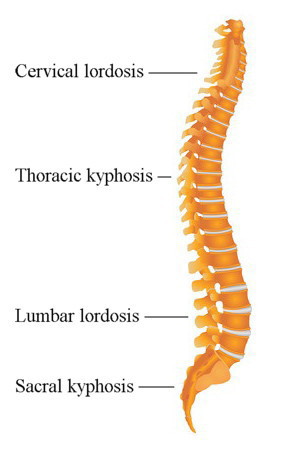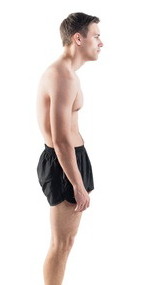Cifosis postural
¿Qué es la cifosis postural?
Kyphosis is an exaggerated rounding of the thoracic spine. The thoracic portion of the spine has a normal forward curvature ranging between 20 and 50 degrees. When the curvature is greater than 50 degrees, it is defined as hyperkyphosis, but commonly referred to as kyphosis.
There are many causes of kyphosis, including osteoporosis, genetic defects, neuromuscular disorders, spinal degeneration, nutritional deficiencies, and Scheuermann’s Disease. However, the most common type of kyphosis is Cifosis postural, which results from habitual posture, repetitive movement patterns, and stress.


¿Por qué desarrollamos cifosis postural?
When we’re born, the vast majority of us have naturally perfect posture. Over the years, due to stress, athletic training, fatigue, or long hours at the computer, driving, or using smart phones, our nervous system can actually learn to keep our chest and abdominal muscles somewhat contracted all the time, resulting in postural kyphosis. This is the process of developing muscle memory. The muscular contraction occurs on a subconscious level, and we are typically not aware of the postural adaptation that occurs as our muscles gradually become tighter.
La cifosis resultante de la contracción muscular crónica puede ocurrir a cualquier edad. Para muchas personas, ocurre gradualmente con el tiempo y no se convierte en un problema significativo hasta la mediana edad. Sin embargo, dado que los niños y adolescentes pasan cada vez más tiempo frente a las computadoras y teléfonos inteligentes, la cifosis postural también se está convirtiendo rápidamente en un problema de los jóvenes.

Efectos secundarios de la cifosis postural
Back and neck pain: When the weight of the head and rib cage are pulled in front of the center of gravity, the back and neck muscles automatically contract in order to maintain balance. Habitual contraction of the back and neck muscles can lead to muscle soreness and pain, disc degeneration, and spinal nerve impingement.
Shallow or clavicular breathing: In order to take a full breath, the diaphragm be able to contract downward and push the contents of the abdomen forward. If the abdominal muscles are tight, this action cannot occur and breathing becomes shallow and strained.
Chronic compression in the front of the body also puts pressure on all the internal organs, contributing to high blood pressure, digestive problems, frequent urination, constipation, and impotence.
Cómo los clinical somatics pueden aliviar y corregir la cifosis postural
Muchos entrenadores y fisioterapeutas enseñan ejercicios que fortalecen los músculos de la espalda y los hombros para intentar corregir la cifosis. Estos ejercicios simplemente enseñan a los músculos de la espalda y los hombros a mantenerse tensos, colocando la cabeza, los hombros y la parte superior de la espalda en una posición vertical. Si bien esto puede parecer un enfoque lógico, el resultado final es que tiene músculos contraídos crónicamente tanto en el frente como en la espalda.
El estiramiento tampoco suele ser eficaz para la cifosis. El estiramiento manual alarga los músculos a nivel estructural en lugar de funcional. En otras palabras, el estiramiento simplemente tira de las fibras musculares, alargándolas temporalmente. Por lo general, en unas pocas horas, las fibras musculares comenzarán a volver a su estado contraído.
Ni el estiramiento ni el fortalecimiento abordan de manera efectiva la causa subyacente de la cifosis postural: la contracción muscular involuntaria y aprendida del pecho y los músculos abdominales.
The most effective way to retrain the nervous system to release involuntary muscular contraction is with a movement technique called pandiculation. Pandiculation contracts and releases muscles in such a way that accurate biofeedback is sent to the brain, naturally resetting the alpha-gamma loop, a feedback loop which controls the resting level of contraction in muscles.
La pandiculación es una de las técnicas utilizadas en la Educación Clínica Somática, un método de educación neuromuscular desarrollado por Thomas Hanna. La pandiculación es muy lenta, suave y terapéutica. Se puede hacer de forma práctica con un educador certificado o por su cuenta en casa en forma de ejercicios de cuidado personal.
If you’re interested in learning Clinical Somatics exercises, a great place to start is the Level One Course.
